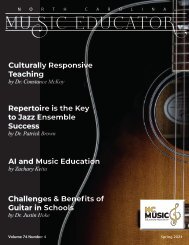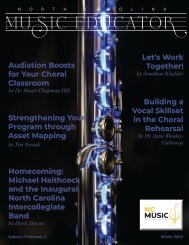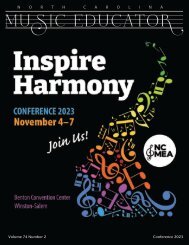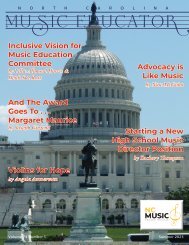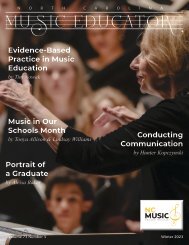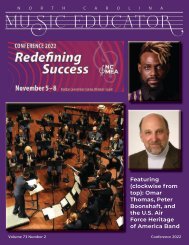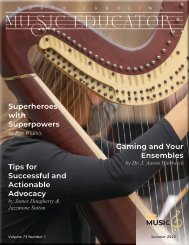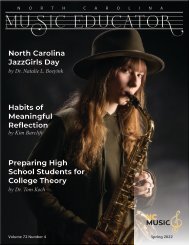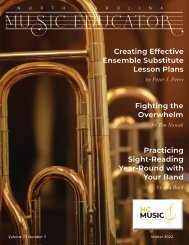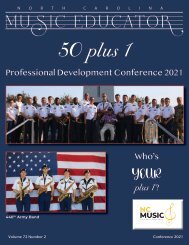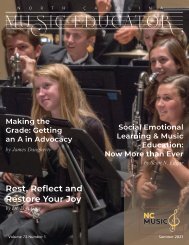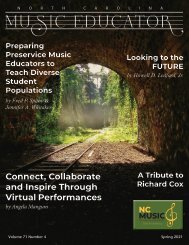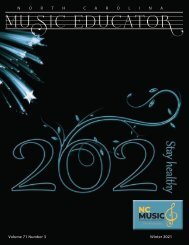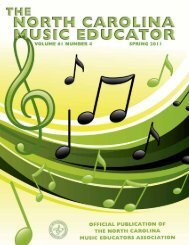Spring 2023
North Carolina Music Educator Journal Spring 2023
North Carolina Music Educator Journal Spring 2023
You also want an ePaper? Increase the reach of your titles
YUMPU automatically turns print PDFs into web optimized ePapers that Google loves.
create your digital program. The end result, however, needs to be<br />
a non-editable file (like a PDF) that can be saved in the cloud (like<br />
on Google Drive, iCloud, etc.). Applications like Microsoft Word,<br />
Microsoft Publisher, Google Docs, Apple Pages, Adobe Elements,<br />
and Affinity Publisher are all great.<br />
You should use what you are most comfortable with. Learning<br />
a new application while preparing a concert performance is not<br />
the goal here. I use Canva. This is online and free. It requires<br />
you to create an account, but the use of the app is free. I like that<br />
Canva is an all-in-one tool that is user-friendly. It allows you to<br />
create beautiful professional-grade programs (there are plenty of<br />
templates) and saves them<br />
on its cloud storage to be<br />
accessed by your audience.<br />
Canva has plenty of other<br />
tools and templates that you<br />
can use to create dynamic<br />
social media posts publicizing<br />
the concert or create and<br />
print flyers and posters for<br />
the concert.<br />
Use QR Codes<br />
Quick Response (QR)<br />
codes have really taken off<br />
as a contactless method<br />
of accessing and sharing<br />
information via smart phone or tablet. Most portable devices have<br />
QR code readers built into them natively, and as QR code use has<br />
increased, more people are comfortable using them. I have been<br />
using QR codes for a while now.<br />
Specifically, I would use them to give parents my contact<br />
information and the music department website at back-to-school<br />
night. It has taken a while, but parents are much more comfortable<br />
and capable of using this method now. I have also always put<br />
the QR code for our music department website on the physical<br />
concert programs and posters.<br />
As mentioned before, to use digital programs you need to<br />
provide the program’s web address to the audience. Converting<br />
the web address to a QR code is a great way of doing this. I project<br />
the code on a screen via LCD projector throughout the concert as<br />
well as hang posters with the codes around the venue. Audience<br />
members just need to view the code with their device (typically<br />
with their smartphone or tablet camera) in order to access the<br />
program.<br />
QR Code<br />
QRCODE MONKEY Free Online QR Code Generator<br />
Administratively, I also use QR codes for<br />
signing students in and out the night of a<br />
concert. I use this tool for both attendance<br />
and as a grading measurement. I create a<br />
Google Form that collects the student names,<br />
ensembles, and student IDs. Each entry also<br />
creates a timecode which further enhances<br />
the record-keeping. This strategy is obviously one to use with<br />
older students who have mobile devices and are capable of using<br />
them this way. As with any class procedure, I find it is absolutely<br />
necessary to teach the students the right way to do this, and it is a<br />
process to finally get it totally right.<br />
To create a QR code, simply place the web address into a QR<br />
Code Generator. There are a many different ones online. Some<br />
cost money, some require you to create an account, but many do<br />
not. I like to use QR Code Monkey. Once the application generates<br />
the QR code, it then coverts it to a graphics file (typically PDF or<br />
PNG) you can download and use in your content material.<br />
The strategies explained<br />
here can streamline your<br />
concert preparation as<br />
well as enhance your<br />
concertgoers’ experience. I<br />
highly recommend trying<br />
one or both of these for<br />
your next concert. I do,<br />
however, also recommend<br />
that you do what is<br />
comfortable.<br />
Technology should<br />
help our process not<br />
hinder it. These strategies<br />
incorporate some<br />
pandemic teaching technology skills with the technology everyone<br />
carries around with them. Together, this tool can hopefully make<br />
your concert preparation less hectic and more productive.<br />
I outline these tips as well as many other ways to<br />
use technology in ensemble teaching on my website:<br />
www.peterperrymusic.net and in my book Technology Tips for<br />
Ensemble Teachers, published by Oxford University Press. Feel free<br />
to check them out. I hope these suggestions help.<br />
Have a great concert season!<br />
Peter Perry is a lifelong Maryland resident<br />
and has traveled the world teaching and<br />
performing music. A NAfME member, he is<br />
currently in his twenty-sixth consecutive year<br />
as Instrumental Music Director at Richard<br />
Montgomery High School in Rockville,<br />
Maryland. Here he conducts the: Chamber<br />
Orchestra, Concert Orchestra, Pit Orchestra,<br />
Symphonic Band, Jazz Ensemble, Concert<br />
Band, and Marching Band. These ensembles consistently receive critical<br />
acclaim on local, state, and national levels.<br />
Follow Dr. Perry on Twitter: @peterperry101 or at<br />
www.peterperrymusic.net.<br />
12 | NORTH CAROLINA MUSIC EDUCATOR NORTH CAROLINA MUSIC EDUCATOR | 13




